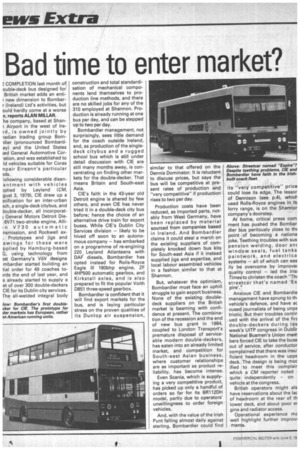Bad time to enter market?
Page 26

If you've noticed an error in this article please click here to report it so we can fix it.
E COMPLETION last month of ouble-deck bus designed for British market adds an entie new dimension to Bomber(Ireland) Ltd's activities, but ould hardly come at a worse e, reports ALAN MILLAR.
!he company, based at Shan1 Airport in the west of IreId, is owned jointly by -radian trading group Bomtiler (pronounced Bombarday) and the United States ;ed General Automotive Cor-ation, and was established to Id vehicles suitable for Coras npair Eireann's particular
3c1s.
rollowing considerable disenantment with vehicles )plied by Leyland (CM, gust 3, 1979), CIE drew up a :cification for an inter-urban :ch, a single-deck citybus, and louble-decker, all incorporatI General Motors Detroit Die6V71 two-stroke engine, Allin V730 automatic nsmission, and Rockwell ax. Prototypes and jigs and awings for these were pplied by Hamburg-based G, using, technology from :st Germany's V,EN designs mbardier started building an tial order for 49 coaches toirds the end of last year, and s already started to supply a et of over 300 double-deckers CIE for its Dublin city services. The all-welded integral body
construction and total standardisation of mechanical components lend themselves to production line methods, and there are no skilled jobs for any of the 310 employed at Shannon. Production is already running at one bus per day, and can be stepped up to two per day.
Bombardier management, not surprisingly, sees little demand for the coach outside Ireland, and, as production of the singledeck citybus and a rugged school bus which is still under detail discussion with CIE are still many months away, is concentrating on finding other markets for the double-decker. That means Britain and South-east Asia.
CIE's faith in the 43-year old Detroit engine is shared by few others, and even CIE has never tried it in a double-deck city bus before; hence the choice of an alternative drive train for export buses. While CIE's Dublin City Services division — likely to be hived off soon to an autonomous company — has embarked on a programme of re-engining 220 , Leyland Atlanteans with DAF diesels, Bombardier has opted instead for Roils-Royce Eagle lH 180bhp engine, ZF 4HP500 automatic gearbox, and Kirkstall axles, and is also prepared to fit the popular Voith D851 three-speed gearbox, Bombardier is confident that it will find export markets for the bus, and is laying particular stress on the proven qualities of its Dunlop air suspension, similar to that offered on the Dennis Dominator. It is reluctant to discuss prices, but says the bus will be competitive at 'present rates of production and "very competitive" if production' rises to two per day.
Production costs have been reduced, as imported parts, notably from West Germany, have been replaced by material sourced from companies based in Ireland. And Bombardier claims it could steal a march on the existing suppliers of completely knocked down bus kits for South-east Asia if it instead supplied jigs and expertise, and local labour assembled vehicles in a fashion similar to that at Shannon.
But, whatever the optimism, Bombardier must face an uphill struggle to gain export business. None of the existing doubledeck suppliers on the British market is beaming with confidence at present. The combination of the recession and the end of new bus grant in 1984, coupled to London Transport's premature disposal of serviceable modern double-deckers, has eaten into an already limited market, and competition for South-east Asian business, where customer relationships are as important as product reliability, has become intense.
Even Scania, which is supplying a very competitive product, has picked up only a handful of orders so far for its BR:112DH model, partly due to operators' unwillingness to order foreign vehicles.
And, with the value of the Irish Punt falling almost daily against sterling, Bombardier could find its "very competitive" price could lose its edge. The lessor of Dennison (see p.4), which used Rolls-Royce engines in its lorry range, is on the Shartnor company's doorstep.
At home, critical press corn ment has pushed the Bombar dier bus perilously close to th( point of becoming a nationa joke. Teething troubles with sus pension welding, door an( window seals, fuel tanks paintwork, and electrica systems — all of which can eas ily be overcome by improve( quality control — led the Irisl Times to christen the coach "Thr streetcar that's named 'Ex pire',"
Anxious CIE and Bombardie management have sprung to th,
vehicle's defence, and have ac cused journalists of being unpa triotic. But their troubles contin ued with the arrival of the fir5 double-deckers during las week's UITP congress in Du blir National Busmen's Union mem bers forced CIE to take the buse out of service, after conductor
complained that there was insu.
ficient headroom in the uppE deck. The design is being moc ified to meet this complair which a CM reporter noted quite independently — on vehicle at the congress.
British operators might als have reservations about the lac of headroom at the rear of th lower deck, and about poor er gine and radiator access.
Operational experience ME well highlight further improvi men ts.












































































































